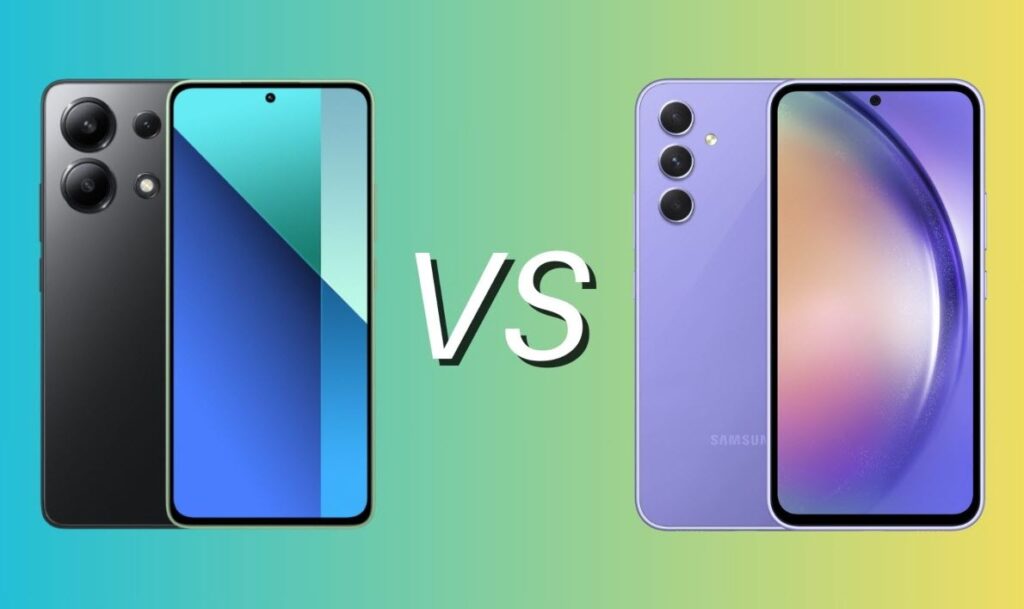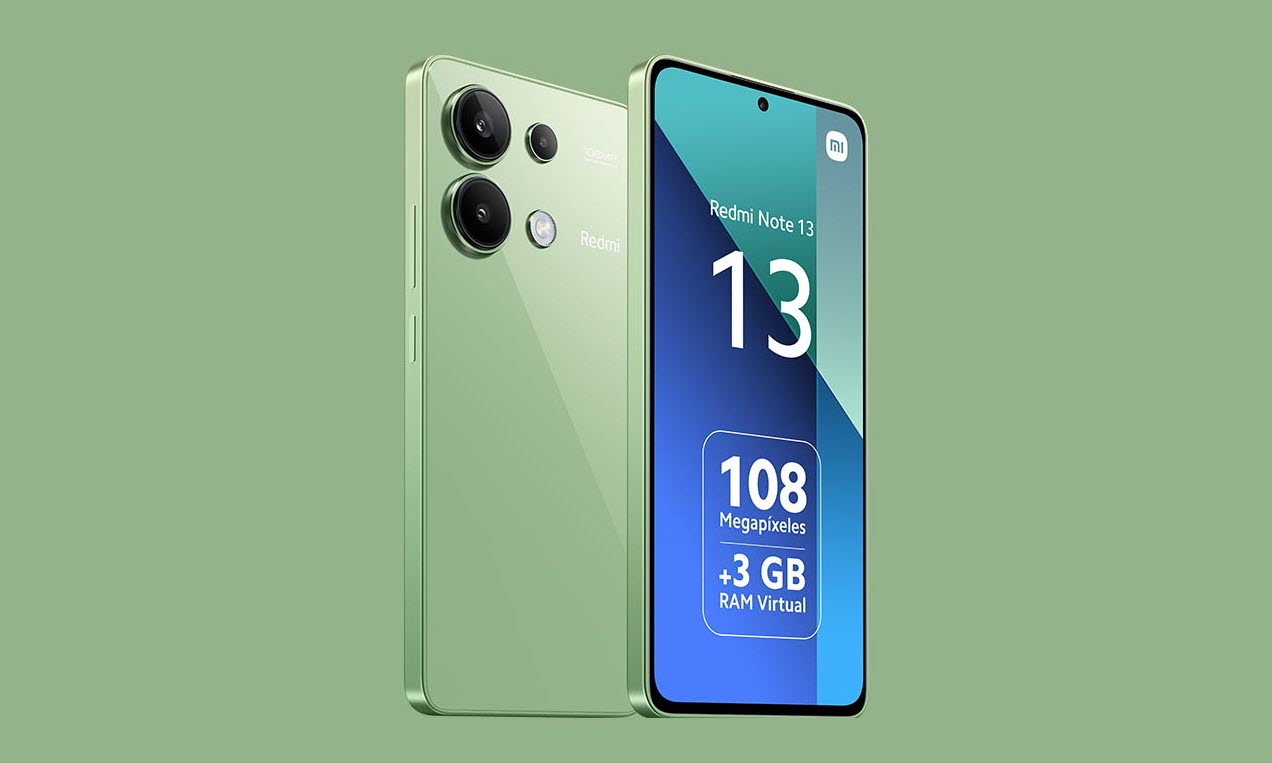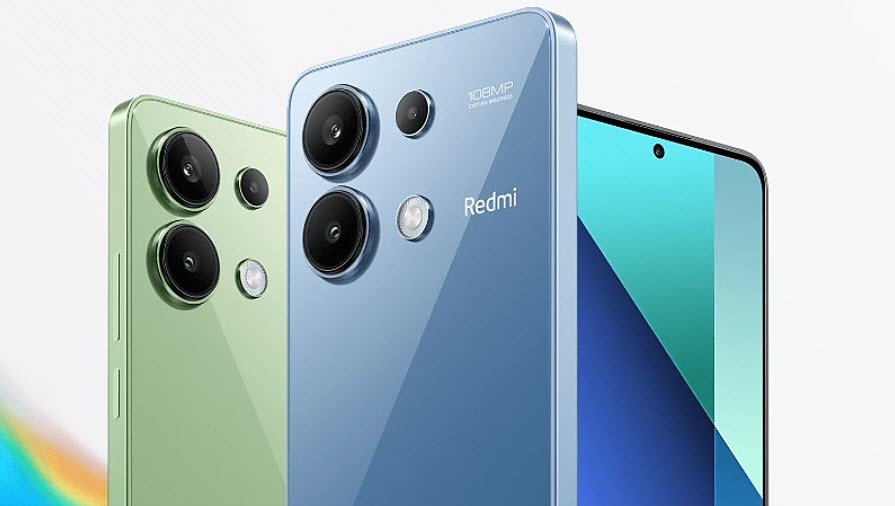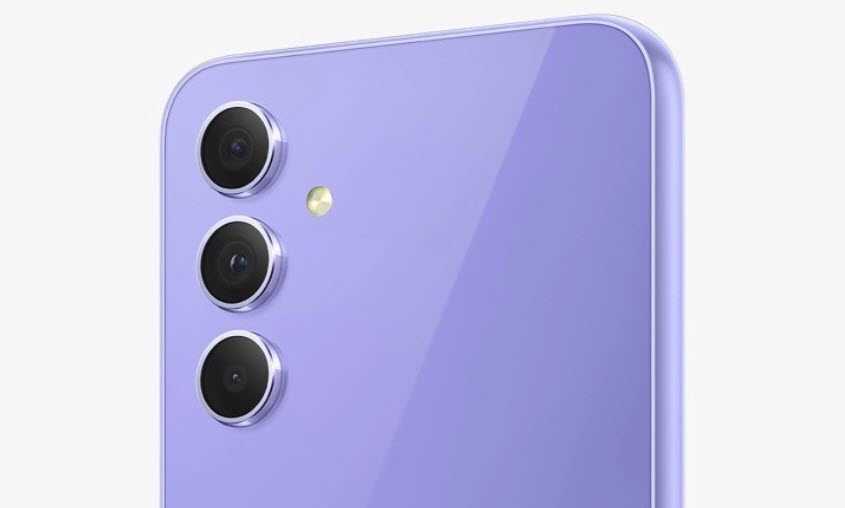Smartphones & Tablets | March 2, 2024

| Redmi Note 13 (4G version) | Samsung Galaxy A54 | |
| Screen | 6.67 inches of AMOLED technology, 20:9 format, FullHD+ resolution of 2,400 x 1,080 pixels, 120 Hz adaptive refresh rate, 240 Hz touch sampling rate, 1,800 nits maximum brightness, HDR10+ and Corning Gorilla Glass 3 protection | 6.4 inches of Super AMOLED technology, 19.5:9 format, FullHD+ resolution of 2,340 x 1,080 pixels, 120 Hz refresh rate, 240 Hz touch sampling rate, 1,000 nits maximum brightness, HDR10 and Corning Gorilla Glass 5 protection |
| Main camera | – 108-megapixel main sensor with f/1.8 focal aperture with video recording capacity in FullHD 1080p resolution at 30 frames per second – 8-megapixel wide-angle secondary sensor with f/2.2 aperture – 2-megapixel tertiary macro sensor megapixels with f/2.4 aperture | – 50 megapixel main sensor with f/1.8 focal aperture with video recording capacity in 4K resolution at 30 frames per second – 12 megapixel wide-angle secondary sensor with f/2.2 aperture – 5 megapixel tertiary macro sensor with f/2.4 aperture |
| Selfie camera | 16 megapixel main sensor with f/2.4 focal aperture with video recording capacity in FullHD 1080p resolution at 30 frames per second | 32 megapixel main sensor with f/2.2 focal aperture with video recording capacity in 4K resolution at 30 frames per second |
| Internal memory | 128 or 256 GB of UFS 2.2 type | 128 or 256 GB of UFS 2.2 type |
| Extension | Expandable via microSD card up to 1TB | Expandable via microSD card up to 1TB |
| Processor and RAM memory | – Qualcomm Snapdragon 685 6 nanometers and eight cores at 2.8 GHz max. – 6 or 8 GB of LPDDR4 type RAM | – Samsung Exynos 1380 5 nanometer eight-core 2.4 GHz max. – 6 or 8 GB of LPDDR4 type RAM |
| Battery | 5,000 mAh with support for 33W fast wired charging (charger included in the box) | 5,000 mAh with support for 25W fast wired charging (charger not included in the box) |
| OS | Android 13 under MIUI 14 | Android 13 under One UI 5.1 |
| Connections | 4G LTE, dual-band WiFi 802.11 a/b/g/n/ac, Bluetooth 5.1, GPS with A-GPS and GLONASS, NFC for contactless mobile payments and USB type C | 5G, 4G LTE, dual-band WiFi 802.11 a/b/g/n/ac/6, Bluetooth 5.3, GPS with A-GPS and GLONASS, NFC for contactless mobile payments and USB type C |
| SIM | Dual nano SIM | Dual nano SIM |
| Design | Colors: black, green and blue | Colors: black, white, blue and lavender |
| Dimensions and weight | 162.2 x 75.5 x 8 millimeters and 188.5 grams | 158.2 x 76.7 x 8.2 millimeters and 202 grams |
| Featured Features | Under-screen optical fingerprint sensor, facial recognition, stereo speakers with Dolby Atmos, infrared sensor, and IP54 water and dust resistance (splash-proof) | Under-display optical fingerprint sensor, facial recognition, stereo speakers with Dolby Atmos, and IP67 water and dust resistance (submergence-proof) |
| Release date | Available | Available |
| Price | From 170 euros | From 310 euros |
The Redmi Note 13 4G was recently introduced as the new king for the mid-range price-quality ratio of 2024. However, there are doubts about whether it is truly the best phone in this segment since there is also the Samsung Galaxy A54, one that we have compared on different occasions and has been competing for this title for almost a year. Both phones are among the most interesting ones today, thanks to their value for money. Now, what is not entirely clear is which one is better and why. To find out, we will analyze their differences in terms of features and prices in this comparison of the Redmi Note 13 vs. Galaxy A54. Which one will win? Let’s see.

When we talk about the Redmi Note 13, we are talking about a very different phone from the Galaxy A54. Although it shares some design characteristics with the latter, such as the straight edges and the punch-hole screen for the camera, it differs greatly from what we find on the Samsung phone when we take a look at its cameras, which not only have a different layout but also two of the three lenses are enclosed in much larger lenses that give them more prominence.
As for which one is more aesthetic and attractive, this is subjective, a matter of personal preference. What we can say is that the Samsung Galaxy A54 boasts better build quality. For this reason, it feels more premium in hand, thanks to having a glass back. The Redmi Note 13’s back is plastic, although it somewhat mimics glass due to its reflective nature. The frames of both phones are also plastic, so there is not much difference here. Now, where we do find more differences between the Redmi Note 13 vs. Galaxy A54 is in weight, with the latter being the heavier of the two by almost 14 grams. Regarding dimensions, the Xiaomi Redmi Note 13 4G is taller but also thinner and narrower, which makes it easier to grip.
In terms of screens, there are only three similarities between both phones. The first is the refresh rate, which is 120 Hz on both phones. However, the Redmi Note 13’s is adaptive, so it can vary according to the current usage. Then we have the touch sampling rate, which is 240 Hz on both. However, with the game mode activated, this can increase to 2,160 Hz on the Redmi Note 13, making it much more responsive than the Galaxy A54 for gaming. They also both feature a Full HD+ resolution, but it’s 2,400 x 1,080 pixels on the former and 2,340 x 1,080 pixels on the latter.
In other aspects, the screens of these devices are completely different. While the Redmi Note 13 4G’s screen measures 6.67 inches and reaches a maximum brightness of 1,800 nits, the Samsung Galaxy A54’s has a diagonal of 6.4 inches and is almost 50% less bright, with a maximum brightness of 1,000 nits. The Redmi Note 13’s screen is also HDR10+ compatible and is protected by Corning Gorilla Glass 3. The Galaxy A54’s, on the other hand, supports the HDR10 standard and is coated with Gorilla Glass 5, which is more resistant.

The Redmi Note 13 4G has fairly good performance for day-to-day use, which means it can run most apps and games from the Play Store smoothly, as long as they are not very demanding in terms of graphics and resources. The same can be said for the Galaxy A54, although it has better performance thanks to the chipset processor it carries inside, which is the Exynos 1380, a 5-nanometer chip with eight cores clocked at up to 2.4 GHz.
The one in the Redmi Note 13 is the Qualcomm Snapdragon 685, a 6-nanometer processor that also has eight cores, with the difference that these can reach a higher clock frequency of 2.8 GHz. Despite the latter, as mentioned earlier, it achieves lower performance than the aforementioned Exynos 1380 of the Galaxy A54, and this is reflected in the results of benchmark power tests such as AnTuTu and Geekbench.
Regarding memory options, there are no differences between the Samsung Galaxy A54 vs. Redmi Note 13 as both come with UFS 2.2 internal memory of 128 or 256 GB and 6 or 8 GB LPDDR4 RAM. In turn, both support a microSD card of up to 1 TB for expanding internal storage space.

We continue with the comparison of the Samsung Galaxy A54 vs. Xiaomi Redmi Note 13. Now let’s take a look at their cameras, where there are also significant differences. While both opt for a triple camera setup, the configuration of their sensors is by no means similar.
The Redmi Note 13 4G has a 108-megapixel main sensor with an aperture of f/1.8 that can record Full HD 1080p video at 30 frames per second. It also has an 8-megapixel ultra-wide with an aperture of f/2.2 and a 2-megapixel macro with an aperture of f/2.4. The Samsung Galaxy A54, on the other hand, uses a 50-megapixel main camera with an aperture of f/1.8 that records in 4K at 30 frames per second, a 12-megapixel ultra-wide with an aperture of f/2.2, and a 5-megapixel macro with an aperture of f/2.2.
The front camera of the Redmi Note 13 is 16 megapixels, has an aperture of f/2.2, and records in Full HD 1080p at 30 frames per second. The one on the Samsung A54 has a higher resolution and its recording has a higher video quality, being 32 megapixels, having an aperture of f/2.2, and recording in 4K at 30 frames per second.

We continue with the comparison of the Galaxy A54 vs. Redmi Note 13. The next thing we will see is the battery section, where both share a 5,000 mAh battery. For this reason, both achieve similar autonomy, which is between 1 and 2 days with a single charge. However, the Redmi Note 13 supports faster charging than the Galaxy A54, as it has 33 W compared to the latter’s 25 W. Due to this difference, the Redmi Note 13 takes about 1 hour to fully charge. In contrast, the Galaxy A54 takes approximately 1 hour and almost 20 minutes. It’s worth noting that only the Redmi Note 13 includes its charger in the box.
In terms of connectivity, only the Samsung Galaxy A54 supports 5G networks. Additionally, it has more advanced Bluetooth and Wi-Fi versions, which are Bluetooth 5.3 and Wi-Fi 6. The Redmi Note 13, on the other hand, comes with Bluetooth 5.1 and Wi-Fi 5. Otherwise, both come with 4G LTE, NFC for contactless payments, GPS with A-GPS and Glonass, and a USB Type-C port. However, only the Redmi Note 13 includes an infrared sensor that allows it to act as a remote control for household appliances such as TVs and air conditioners.
Among other features, both include an in-screen optical fingerprint reader, as well as facial recognition. They also have dual stereo speakers with Dolby Atmos and water resistance, but it’s IP54 on the Redmi Note 13 and IP67 on the Galaxy A54. This means that the former is only resistant to splashes, while the Samsung phone is immersion-proof. It is also worth noting that the Redmi Note 13 is the only one of the two that includes a protective case in the box.
Regarding software, both come with Android 13, but the Redmi Note 13’s interface is MIUI 14 and the Samsung Galaxy A54’s is One UI 5.1, although in some markets and regions, the latter has already received the Android 14 update under One UI 6.1. The support for updates of the Redmi Note 13 has not been well defined by Xiaomi. However, it is estimated to be 2 years. If you’re lucky, it will be up to 3 years. This means it would be upgradeable to Android 15 or, in the best case, Android 16. On the other hand, the Galaxy A54, having a more generous update support of 4 years, will be upgradeable to Android 17.
We have analyzed all the differences between the Xiaomi Redmi Note 13 vs. Samsung Galaxy A54, so now let’s take a look at their prices and then define the winner of this showdown.
The Redmi Note 13 4G can currently be purchased for around 170 euros on sites like Amazon, while the Galaxy A54 can be obtained for around 310 euros. The difference between the two is approximately 140 euros in favor of the Redmi Note 13, being the cheaper of the two. With this in mind, there is no doubt that Xiaomi’s bet is the best in terms of value for money. However, if we talk about features, the Samsung Galaxy A54 is superior in most technical aspects, which is why it is the winner of this comparison.
The Samsung Galaxy A54 is better than the Redmi Note 13 for several reasons. First, it has a more complete camera system that not only takes higher quality photos but also records at a higher resolution, both with the main and front cameras. Its performance is also above what the Redmi Note 13 offers, making it better for running apps and games more smoothly. Additionally, it features 5G connectivity, as well as more advanced Bluetooth and Wi-Fi versions. It also has a more generous update support, comes with IP67 water resistance, and boasts a more premium design with glass on its back.
The Redmi Note 13 also has its virtues. One of them is its screen, which is larger and brighter. It also has an infrared sensor, as well as a more powerful fast charging. At the same time, it is easier to hold in hand, being lighter, narrower, and thinner. And not to mention the screen bezels, which are more trimmed than those of the Galaxy A54. It’s also appreciated that it includes a charger in the box, as well as a protective case.